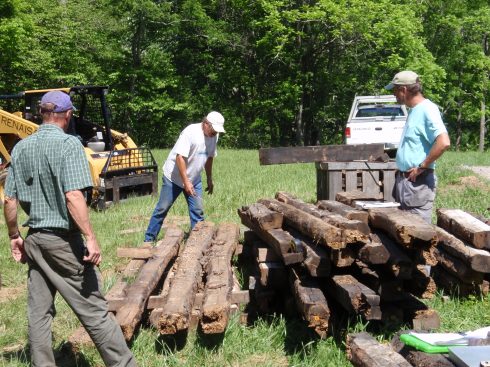My buddies finished moving and erecting the first log cabin this week.
The cribs were in pretty bad shape – some logs were completely rotted from water invasion and some had been attacked pretty severely by termites. We were only able to re-use about 2/3rds of the logs, and they weren’t quite enough to build a structure. Below, Jim Callahan and Jack Taylor of Highland Timberframe, and Al Anderson of Timberframes of Interest sort through and inventory the damaged logs looking for the good ones.

Sorting Logs
We sawed new white oak sill logs, and poplar top plates from logs that had been cut last fall in the big woods. That gave us enough to build an equipment shed.
The fellers dug a footer all around and filled it with gravel, then placed some BIG flat, relatively square rocks at each corner to support the structure the old timey way. The sill logs were sawn on only two sides and hand-notched to match the original logs.

New sill/foundation rock
Traditional joinery is used – the cut logs in the doors and windows are even supported using locust pegs.

Pegged Joinery
100% of the additional lumber for the rest of the building was harvested on the property of dead, diseased and dying trees, using horse-logging, and sawn on the property.
The end result is a log structure that will preserve the original work and materials that could be saved, and creates an environment for their preservation, using only a few modern methods. The roofing is the one thing that isn’t at all historically accurate, but hey – it matches the roof of the other equipment shed at the other end of the field. And we weren’t about to split a bunch of oak shakes or something. It’s just an equipment shed 😉

Log Equipment Shed
In a couple of years, when the new wood is weathered, it might just look like it was always here.

Log Equipment Shed

1 comment
Comments feed for this article
July 12, 2009 at 11:37 am
Jeff
Very interesting, Chris. I see that one of the cribs is open on one side, presumably so that you can drive equipment in. The other one has openings for doors and windows – are you going to show us how that portion is finished off? What are you going to fill the gaps between the logs with – soil mixed with chopped straw, maybe? It’s very nice that you were able to re-use two-thirds of the logs. I’ll be looking forward to more installments on your project!